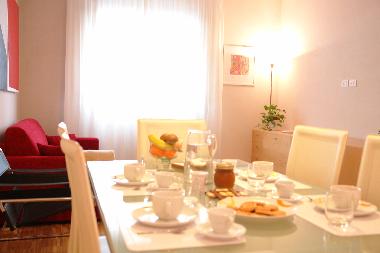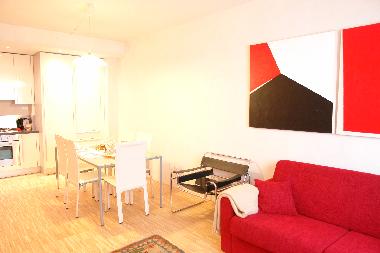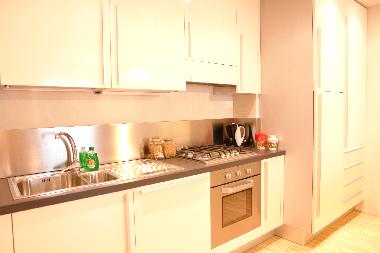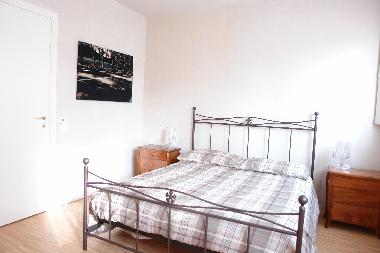Name of object: Apartment in the Arezzo city\\\'s heart | |
| Italy - Tuscany - Arezzo - Holiday Apartment Arezzo | | Object number: | 50986 |
| Creation date: | 18.02.2013 |
| Type of object: | Holiday Apartment, detached |
| Living area: | 65 m2 |
| Number of rooms: | 2 |
| Number of sleeping accommodations (sleeps): | 4 |
| Number of bathrooms: | 1 |
Rental Price55 Euro per object per day
Price includes following expenses- Cleaning (negotiable)
- Cleaning (weekly)
- Electricity
- Gas
- Internet flat-rate
- Water
Description of objectLuminous and beautifully decorated apartment in the city centre on the second floor (with elevator) in a prestigious building of new construction, composed of wide living room with American kitchen, dining table for 6, couch/sofa-double bed, large double bedroom with wardrobe, bathroom with shower, a bed additional bed for children up to 4 years of age. Direct access to the main cultural and tourist attractions, in addition to local shopping streets and restaurants of typical food. \\\'
Location of objectNear all amenities necessary for a pleasant stay including restaurants, pizzeria, sushi, wine bars, shops, discos, cinemas, supermarkets, pharmacies. The apartment is located within walking distance from Piero della Francesca\\\'s frescoes, the Roman Amphitheater, the Fortezza Medicea, the famous Antiquities Fair that takes place in Arezzo since 1968 every first Sunday of the month (and previous Saturday) in addition to the Giostra del Saracino each last Saturday of June and every first Sunday of September. The owners will be happy to advise you on the best that there is to do in the city. The apartment is located 8 minutes away by car from the A1, Arezzo exit towards the city centre, and 5 minutes walk from the railway station. Cortona 29 km Anghiari 30 km Siena 65 km Florence 70 km Perugia 76 Montalcino 82 San Gimignano 110 \\\'
Town: Italy, Tuscany, ArezzoGB: Described by Livy as one of the Capitae Etruriae (Etruscan capitals), Arezzo is believed to have been one of the twelve most important Etruscan cities—the so-‐called Dodecapolis. Etruscan remains establish that the acropolis of San Cornelio, a small hill next to that of San Donatus, was occupied and fortified in the Etruscan period. There is other significant Etruscan evidence: parts of walls, an Etruscan necropolis on Poggio del Sole (still named \\\'Hill of the Sun\\\'), and most famously, the two bronzes, the \\\'Chimera of Arezzo\\\' (5th century BC) and the \\\'Minerva\\\' (4th century BC) which were discovered in the 16th century and taken to Florence. Increasing trade connections with Greece also brought some elite goods to the Etruscan nobles of Arezzo: the krater painted by Euphronios ca 510 BC with a battle against Amazons (in the Museo Civico, Arezzo 1465) is unsurpassed.
Conquered by the Romans in 311 BC, Arretium became a military station on the via Cassia, the road to expansion by republican Rome into the basin of the Po. Arretium sided with Marius in the Roman Civil War, and the victorious Sulla planted a colony of his veterans in the half-‐demolished city, as Arretium Fidens (\\\'Faithful Arretium\\\'). The old Etruscan aristocracy was not extinguished: Gaius Cilnius Maecenas, whose name is eponymous with \\\'patron of the arts\\\', was of the noble Aretine Etruscan stock. The city continued to flourish as Arretium Vetus (\\\'Old Arretium\\\'), the third largest city in Italy in the Augustan period, well known in particular for its widely-‐exported pottery manufactures, the characteristic moulded and glazed Arretine ware, bucchero-‐ware of dark clay and red-‐painted vases (the so-‐called \\\'coral\\\' vases).
Around 26-‐261 AD the town council of Arezzo dedicated an inscription to its patron L. Petronius Taurus Volusianus. See that article for discussion of the possible political/military significance of Volusianus\\\'s association with the city.
In the 3rd to 4th century, Arezzo became an episcopal seat: it is one of the few cities whose succession of bishops are known by name without interruption to the present day, in part because they were the feudal lords of the city in the Middle Ages. The Roman city was demolished, partly through the Gothic War and the invasion of the Lombards, partly dismantled, as elsewhere throughout Europe, and the stones reused for fortifications by the Aretines. Only the amphitheater remained.
The commune of Arezzo threw off the control of its bishop in 1098 and was an independent city-‐ state until 1384. Generally Ghibelline in tendency, it opposed Guelph Florence. In 1252 the city founded its university, the Studium. After the rout of the Battle of Campaldino (1289), which saw the death of Bishop Guglielmino Ubertini, the fortunes of Ghibelline Arezzo started to ebb, apart from a brief period under the Tarlati family, chief among them Guido Tarlati, who became bishop in 1312 and maintained good relations with the Ghibelline party. The Tarlati sought support in an alliance with Forlì and its overlords, the Ordelaffi, but failed: Arezzo yielded to Florentine domination in 1384; its individual history was subsumed by that of Florence and the Medicean Grand Duchy of Tuscany. During this period Piero della Francesca worked in the church of San Francesco di Arezzo producing the splendid frescoes, recently restored, which are Arezzo\\\'s most famous works. Afterwards the city began an economical and cultural decay, which fortunately ensured that its medieval centre was preserved.
In the 18th century the neighbouring marshes of the Val di Chiana, south of Arezzo, were drained and the region became less malarial. At the end of the century French troops led by Napoleon Bonaparte conquered Arezzo, but the city soon turned into a resistance base against the invaders with the \\\'Viva Maria\\\' movement, winning the city the role of provincial capital. In 1860 Arezzo became part of the Kingdom of Italy. City buildings suffered heavy damage during World War II. Pope Benedict XVI visited Arezzo and two other Italian municipalities on Sunday, May 13, 2012.
Link to our websitewww.casavacanzaadarezzo.blogspot.com
Arrival and distancesArrival day: negotiable
Distance to next airport: Leonardo Da Vinci - Firenze 60 Km
Distance to next motorway: Arezzo 5 Km
Distance to the sea: Tirreno and Adriatico 100 Km
Distance to next shop: 0.1 Km
Sport facilities nearbyCycling, Golf, Horse riding, Mountainbiking, Swimming, Tennis,
Theme of holidays- City holidays
- Cultural and sighseeing holidays
- Family holidays
- Holidays for singles
- Relaxing holidays
- Romantic holidays
Total sleeping facilities and distributionTotal number of sleeping facilities: 3
- thereof 1 Single room(s)
- thereof 1 Double room(s)
- thereof 1 Other sleeping rooms
BathroomsNo. of bathrooms: 1- thereof Bathrooms with shower: 1
External facilities of objectInternal facilities of objectMachines and equipment- Linen provided
- Permanent internet connection
- Towels provided
- TV
Kitchen facilities- 4 ring stove
- Dish washer
- Freezer
- Fridge
- Microwave
ServicesOther- Handicapped: not specified
- Seniors: not specified
- Children: welcome
- Pets: negotiable
CateringCatering: Self catered (extra)
|
|
















